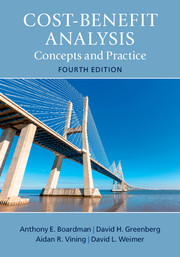Chapter 2 - Conceptual Foundations of Cost-Benefit Analysis
from PART I - OVERVIEW
Summary
It seems only natural to think about the alternative courses of action we face as individuals in terms of their costs and benefits. Is it appropriate to evaluate public policy alternatives in the same way? The CBA of the highway sketched in Chapter 1 identifies some of the practical difficulties analysts typically encounter in measuring costs and benefits. Yet, even if analysts can measure costs and benefits satisfactorily, evaluating alternatives solely in terms of their net benefits may not always be appropriate.
An understanding of the conceptual foundations of CBA provides a basis for determining when CBA can be appropriately used as a decision rule, when it can usefully be part of a broader analysis, and when it should be avoided. The goal of allocative, or Pareto, efficiency provides the conceptual basis for CBA. In this chapter we provide a nontechnical introduction to Pareto efficiency. We then explain its relationship to potential Pareto efficiency, which provides the practical basis for actually doing CBA. Our exploration of the roles of Pareto efficiency and potential Pareto efficiency in CBA provides a basis for distinguishing it from other analytical frameworks. It also provides a basis for understanding the various philosophical objections commonly made against the use of CBA for decision making.
CBA AS A FRAMEWORK FOR MEASURING EFFICIENCY
CBA can be thought of as providing a framework for measuring efficiency. Though we develop a more formal definition of efficiency in the following section, it can be thought of as a situation in which resources, such as land, labor, and capital, are deployed in their highest valued uses in terms of the goods and services they create. In situations in which analysts care only about efficiency, CBA provides a method for making direct comparisons among alternative policies. Even when goals other than efficiency are important, CBA serves as a yardstick that can be used to provide information about the relative efficiency of alternative policies. Indeed, analysts rarely encounter situations in which efficiency is not one of the relevant goals. Critical evaluation of these assertions requires a more precise definition of efficiency.
- Type
- Chapter
- Information
- Cost-Benefit Analysis , pp. 27 - 51Publisher: Cambridge University PressPrint publication year: 2017



